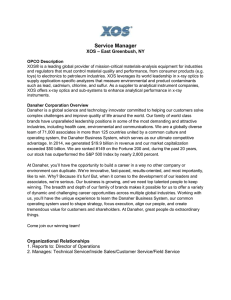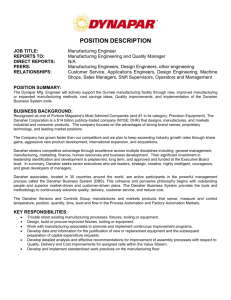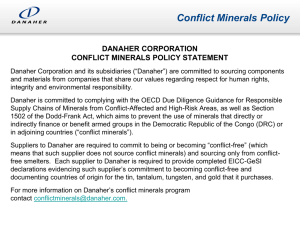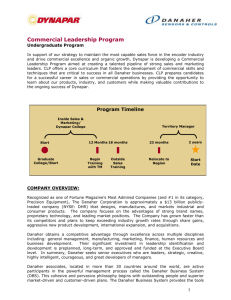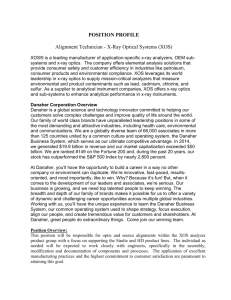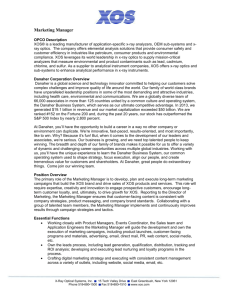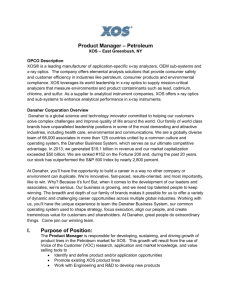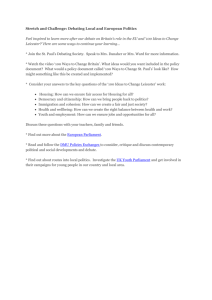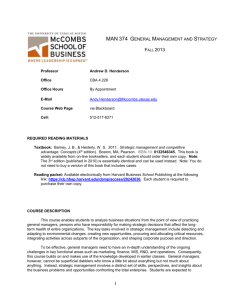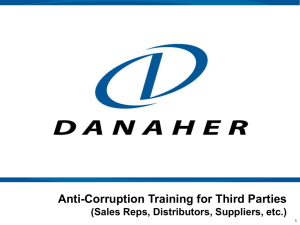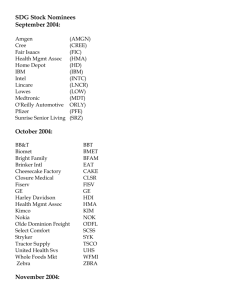Danaher Corporation Case Analysis Ashley Valdez Amanda Lanier
advertisement
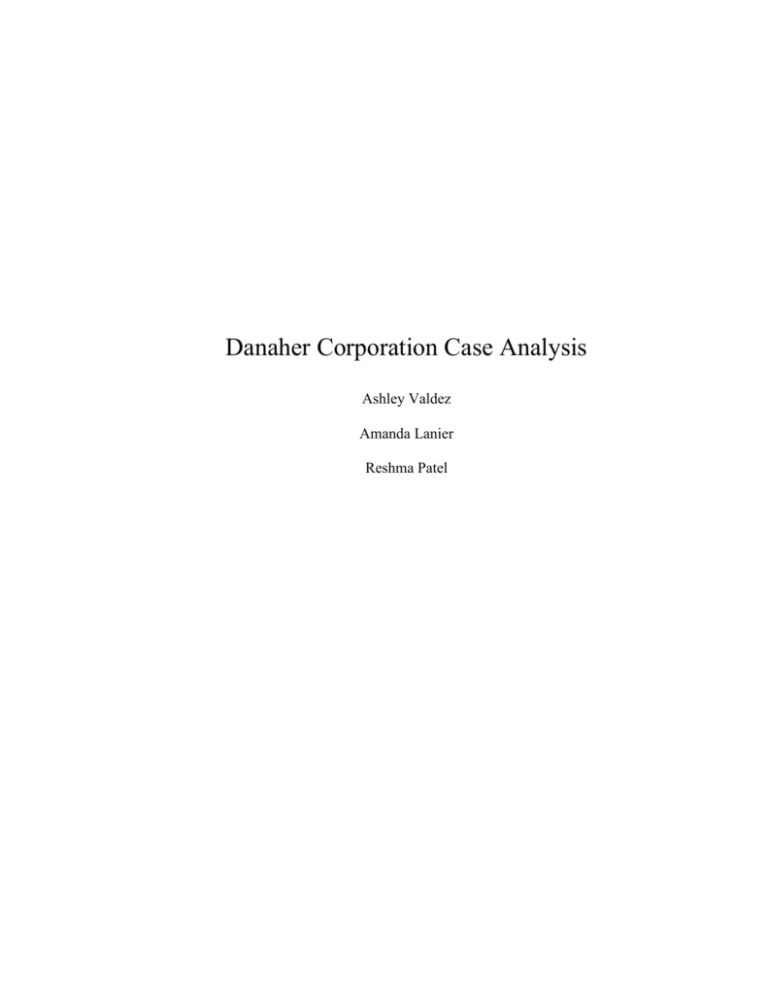
Danaher Corporation Case Analysis Ashley Valdez Amanda Lanier Reshma Patel Corporate History Danaher was first formed in 1980 as a company, called Equity Group Holdings, by two brothers, Steven and Mitchell Rales. The company’s objective was to acquire businesses that had three characteristics: understandable operations in a reasonably defined niche, predictable earnings that generate cash profits and experienced management with an entrepreneurial orientation. (Hesterly) The brothers changed the name to Danaher after they went on a flyfishing trip to the Danaher River in Montana. Corporate Level Strategy After the name change, Danaher began a strategy of creating lean manufacturing through the Danaher Business Strategy (DBS), which mimicked the Toyota Production System, while maintaining a core of “kaizen”, continuous improvement. Moving forward, Danaher started acquiring companies that focused on manufacturing tools, controls, precision components and plastics. Danaher was a fast growing company that had 14 subsidiaries. In 1986, Steven Rales was quoted saying,” If there’s one things that distinguishes us from the other players in the M&A field, it’s that we stay in touch with the companies.” (Hesterly) The company truly cared about the companies it was acquiring and wanted them to succeed. Since 2001, Danaher has started focusing on businesses that had three certain criteria. “First, the market size should exceed $1 billion. Second, core market growth should be at least 5%-7% and without undue cyclicality or volatility. Third, [they] look for fragmented industries with a long tail for participants that have $25-$100 million in sales, and can be acquired for their products without necessarily needing their overheads. Fourth, [they] try to avoid outstanding competitors such as Toyota or Microsoft. Fifth, the target arena should present a good opportunity for applying DBS so that [they] can leverage [their] Danaher skill set. Last, [they] look for tangible product-centric businesses.” (Hesterly) After the business they are looking at falls into these criteria, they were placed into a category. The category they were placed in was based on how the company being acquired related to existing businesses. The three categories included New Platforms, Bolt-Ons and Adjacencies. A new platform is characterized by bringing Danaher into a new market or product. A bolt-on is where the company had to cause “synergies between existing Danaher businesses and new targets.” (Hesterly). Adjacencies were businesses that once acquired were still solely a stand-alone business. Danaher has been recognized for its acquisition strategy through the years. A business consultant commented in Business Week saying, “those guys have a very well-defined model of how to do M&A.” (Hesterly) Diversification Philosophy Danaher Corporation’s diversification philosophy is solely economies of scope. They utilize their core competencies of the DBS system to create lean manufacturing and spread their knowledge to multiple firms they acquire of which are at a smaller level and easier to integrate. They participate in product market diversification because, not only are their products diversified, they also acquire businesses in several countries. Several of their niche businesses fall into four categories: professional instrumentation, industrial technologies, tools and components, and medical technologies. These categories are clearly a variety of distinct industries making Danaher’s diversification unrelated. Danaher expanded their strategy into “Western and Eastern Europe, Asia, Latin America, and the Middle East” (Hesterly) allowing them to be geographically diversified. Based on the precision and success of the DBS, Danaher is trying to create synergy. DBS “requires every employee, from the janitor to the president, to find ways every day to improve the way works get done” (Hesterly). The system mandates every employee top-down to know every aspect of the business and allows them to input their suggestions on improvement. Management, including businesses that have been acquired, must go through training to learn the system. Top management even participate in “kaizen events” (Hesterly) where they have to take a stroll through the manufacturing facility to see how the business is working, is it working properly, what needs to be changed, and create a strategic plan to resolve any issues. They, basically, do a root cause analysis at every acquisition to make sure every aspect of the business runs properly and in sync with all other parts. In conclusion, Danaher is trying to create synergy and do so by following the Danaher Business System. Danaher has a competitive advantage at accomplishing synergy and diversification because there are extremely few firms doing the same thing. Danaher is similar to GE in that their economies of scope are to create products that unrelated to one another. GE has products in aviation, health imaging, railroad engines, nuclear power plants and a broadcast station. Danaher has products medical technology, tools and components, environmental products, aerospace and defense, and industrial. They are all different industries which are hard and somewhat rare to find in businesses. Unrelated diversification is very expensive and a firm must have the capital to maintain the status. Danaher’s core competency and advantage is their knowledge of the DBS system and how to effectively integrate it into every acquisition they obtain. They have leverage compared to their competitors who have fallen behind. At Danaher, the business strategy drives the acquisition and “kaizen” strategy with management effectively executing the system. DBS sustained the culture of Danaher Corporation throughout all their many business acquisitions. DBS, as discussed in the book, is the backbone of the company. Plan, people, process, and performance are the four P’s of the DBS covering the four main elements of the internal part of the business. The people category represents the talent and experience that Danaher bring into the company, plan stands for the ‘what’ and the ‘how’ of the business, process is where you put the plan in action, and after the plan has taken place you get the results of the performance. To calculate the results of the performance Danaher Corporation uses the Policy Deployment tool. The use of DBS was explained through an example of the acquisition of Radiometer. Danaher created a plan and had two executives come in to Radiometer which helped them realize the necessary changes needed to be made. What makes Danaher different from any other company is they don’t like to be the popular company but the more successful one. Before an acquisition, instead of having a few hours of long meeting/interview, they go behind the scene. Danaher believes in order to make a decision you must not sit in a chair for a few hours; you have to see hands on what goes on in the company in order to compare it to the best. It’s easier to see how far they can take the company and to see if it can afford to acquire a certain business. It allows you to see how the daily routine operations take place in the company and create ways to better perform those routine tasks in a more efficient time and increase productivity. Danaher Business System is working well for Danaher Corporation. They have faced minor problems, which are why the credibility of DBS is being questioned, but it seems as if the problems aren’t arising entirely because of malfunctions of the DBS. DBS has been proven a success in the past and it should continue to be helpful in future Danaher operations. The DBS is not only the technical part of Danaher but it also sets out a unique company culture that they continue to build with every new Merger and Acquisition. Danaher Corporations continuous improvement was also due to the DBS. (Add a little more detail and state opinion but do not use “I”. Let me know what you think)
